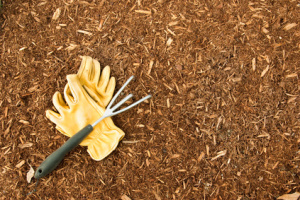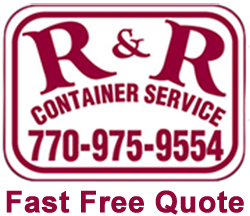Hauling Services
 How does my green waste become mulch?
How does my green waste become mulch?
Green waste is biodegradable waste that consists of garden or lawn clippings, such as grass or flower cuttings and hedge trimmings, as well as food waste (excluding packaging.)
Mulch is a combination of materials spread around or over a plant or soil area to enrich or insulate the soil. There are two types, Organic and Inorganic. Both types consist primarily of Green Waste. Both have important uses in gardening and landscaping.
Organic Mulch
Prevents weed growth, while enriching the soil as it decomposes. Organic Mulch materials do NOT consist of:
- Weeds
- Tree trunks and stumps
- Lumber (plywood, chipboard, etc.)
- Palm fibers
- Wood pallets
- Cactus
- Soil or
- Any non-biodegradable materials (e.g. rocks, metal, plastic)
Inorganic Mulch
Prevents weed growth as well as allowing for added insulation for colder climates to protect growing plants from weather and erosion. Inorganic Much materials often contain several materials not found in the organic variety to increase its endurance.
If you are planning a project at your home or business that will result in large quantities of green waste, think about recycling. Reuse of our natural resource is an important choice in waste disposal.
Click to Call R and R Container Service to learn how we can help you today.
Container Services
Taking out the trash? Where does the trash go when my dumpster is emptied?
In Cobb County, GA and Paulding County, GA, trash is taken to a landfill or transfer station.
A Sanitary Landfill is where non-hazardous waste, residential trash, green waste, construction waste is spread and compacted between layers of soil and dirt.
A Secure Landfill is specifically designed for the disposal of hazardous waste. At these landfills holes and trenches are lined with impervious plastic sheeting to prevent leaking and leaching of environmentally dangerous materials into the soil and water supply.
A Transfer Station is a service offered in many communities that acts as a intermediate location for waste disposal, at which recyclables and refuse are collected and sorted before processing to a final disposal site.
If you have questions regarding disposal of trash, we are also members of the community and are here to assist you. Call today!
Hauling Services
The intent of the LEED Standards for Light Pollution is pretty easy to wrap your mind around:
“To increase night sky access, improve nighttime visibility, and reduce the consequences of development for wildlife and people.”
You can read the standards here.
However, like most of the content on the LEED site, it’s not written for the average consumer/homeowner. Too bad because this is a concept that could greatly benefit people who enjoy the night sky, especially those living in rural areas.
To many I imagine this concept falls in to the category of “It’s my property and I’ll do whatever I want in terms of outdoor lighting!” While this is certainly true in the legal sense (barring communities with light pollution ordinances), it reminds me of being on the deck at a coffee shop or cafe and having someone sit down next to you and start streaming their favorite music from an iPad or laptop through the speakers! Even if it’s my kind of tunes, I don’t want to hear it. It’s just plain rude, use headphones for crying out loud!
So even if you don’t spend any time looking at the night sky, please be considerate when installing outdoor lighting. Some general tips include:
- Don’t install lights which are a lot brighter than you need for the job.
- Try to avoid placing lights very near to your property line (and much closer to your neighbors house)
- When installing rapid on types of lights for security reasons, consider using motion sensors instead of just leaving them burning all night long. You’ll like your electric bill for this one.
- Use lights which are shrouded, directing the light where it’s needed. Avoid flood lights point straight off your property.
But mainly, be considerate. Rest assured that if you’re new security light keeps you neighbor awake many hours a week, the two of you won’t be on good terms.
Hauling Services
Interior Lighting
The intent of the guidelines for interior lighting in the LEED system is to enhance the comfort and well being of people using the spaces. If you’re going to remodel a room or space, this certainly seems like something worth thinking about!
The LEED system looks at two different areas in which to make improvements for interior lighting.
First, they look at how easy it is for the person to control the lighting to get the amount they need for where there are physically located.
Examples include:
- Using multi zone control of your lights with at least 3 levels, on, off, and mid-level. Of course dimmers would be a great solution for this one.
- Lighting designed to show off some piece of the interior or object needs to have its own control.
- The lights being controlled should be in sight of the control, good common sense here.
The second aspect they look at is the actual quality of the lights being used.
This section goes into a lot more details (you can read all of it here on the LEED site), but here’s some basic points form it.
- Limit the brightness of lights that aim between 45 & 90 degrees up from the floor. The idea here is to not have bright lights catching peoples eyes.
- Use light sources that are good at showing the true colors of objects in the space. We’ve all seen kitchens with regular old fluorescent lights, kinda hard on the eyes huh?
- Make sure that for any given space, you use no more than 25% of your total lighting from direct overhead sources. Another way of saying make sure your living room isn’t lit yup like a school classroom!
Hauling Services
The LEED site – a great resource for remodelers
Although LEED is an extensive set of guidelines designed primarily for new construction of commercial and residential buildings, it can also be used as a great resource for the average homeowner who is remodeling an existing home.
Even if you’re only doing a portion of your home, wouldn’t you feel good knowing you’re following the latest ideas in energy conservation and green principals? I think most of us are interested in reducing our carbon footprint and protecting our environment for our kids and grandkids right?
As an example, lets say you’re going to remodel that bathroom or spiff up the kitchen. Wouldn’t it be nice to know the plumbing fixtures you install make good water usage sense? With the dry conditions we’ve seen in northern Georgia in the recent past, this should d be a concern for all of us.
Good news – LEED has a guideline for this:
| Water closets (toilets) |
1.6 gallons per flush (gpf) |
| Private lavatory faucet |
2.2 gpm at 60 psi
|
| Kitchen faucet (excluding faucets used exclusively for filling operations) |
2.2 gpm at 60 psi |
| Showerhead |
2.5 gpm at 80 psi per shower stall |
Bad news – unless you’re pretty savvy with the internet, this info can be hard to locate.
No worries though, over the coming few weeks I’ll pluck some gems out of this enormous government site that I think could be useful to the average homeowner and post them up here where there easy to find.
Stay tuned!
Roll Off Rentals
Understanding Roll Off Dumpster Rental Services
Renting a dumpster, or roll off container, is a simple process.
- Call the dumpster rental company
- Choose a container size
- Have it dropped off at your property
- Fill it up
- Have it hauled away
Handy Information to Know When Dealing with Roll Off Rental Services
- When you’d prefer to clear out the junk/debris yourself, renting a dumpster is the best way to go
- In some situations, such as having a dumpster container dropped off on the side of a city street, you may also need to secure a permit. The dumpster rental company can help determine if this is necessary in your case
- Roll-off dumpsters come in all shapes and sizes with the most common sizes being 10, 20, 30 and 40 yard containers.
- When renting a dumpster, “yards” is referring to the “cubic yard” capacity of the dumpster.
To give you an idea of size ranges & possibilities, here are a couple examples:
- A 10-yard dumpster is ideal for a garage or shed cleanout
- A 40-yard dumpster is the best solution for construction projects or complete re-roofing jobs
Roll Off Rental Services are there to make your life easy. Or at least make your projects less stressful! So don’t be afraid to ask questions. Then go ahead & take the jump. Rental Services for getting rid of waste. Does it get any better? The dumpster rental company you deal with can help you choose the best container for the job!
 How does my green waste become mulch?
How does my green waste become mulch?
